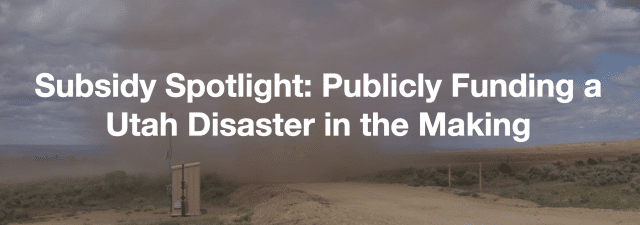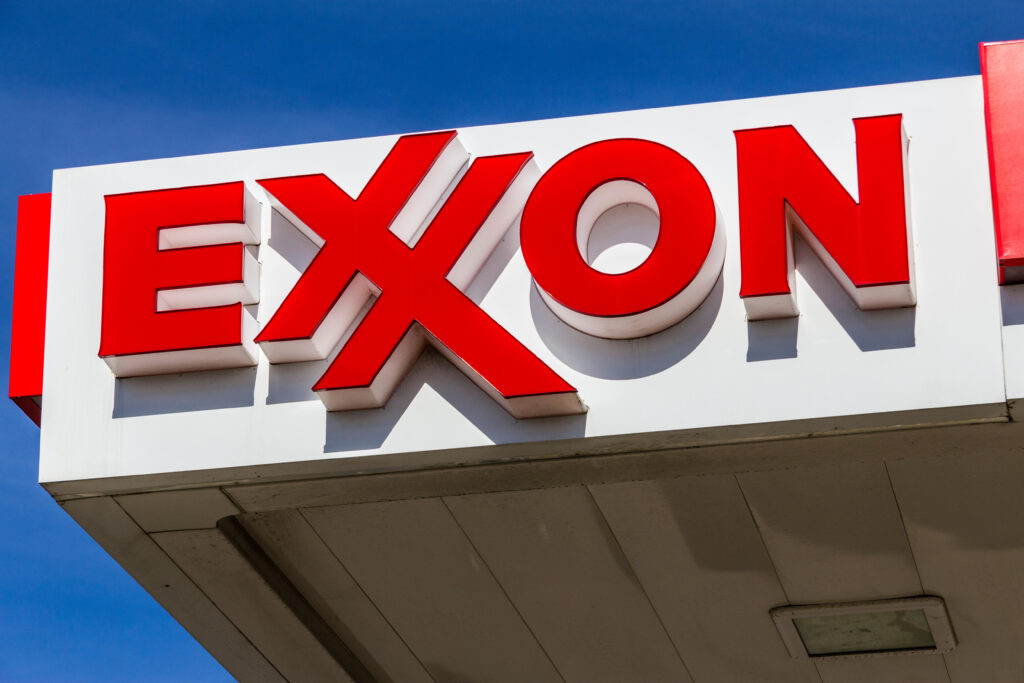This is a guest post by Anna Simonton, on assignment with Oil Change International | Part 1 of 2
A green stegosaurus graces the logo of Uintah County, Utah, a gateway to the famed Dinosaur National Monument, where breathtaking landscapes and fossils preserved in sandstone attract thousands of visitors every year.
That logo has taken on new meaning over the past decade as prehistoric remains have attracted a different crowd. Now oil and gas executives are flocking to the Uinta Basin in Eastern Utah, as new technologies––and support from the government––offer the dubious possibility of digging up the region’s vast deposits of oil shale and tar sands.
Canadian production of tar sands on a massive scale has familiarized the American public with the petroleum substance that’s comprised of sand, clay, water, and bitumen which, after several rounds of energy-intensive refining, can be turned into fuel that burns dirtier than conventional crude oil, releasing more carbon, heavy metals, and sulphur in the process.
But tar sands production has never happened on a commercial scale within the United States, and less attention is paid to domestic reserves––even though several tar sands mining projects have been in the works for a number of years.
In Utah, there’s an estimated 15 billion barrels of oil within the state’s tar sands deposits (that’s a little more than twice the total amount of petroleum consumed in the U.S. in 2013). These tar sands are lower quality than Canada’s, and would require even more processing––using large quantities of fuel just to make more fuel. One report puts it this way, “Every time you fill your car with gas from made-in-Utah tar sands…pour an extra 4 or 5 gallons on the ground.”
Oil shale is even less promising. Not to be confused with shale oil (which is oil released by fracking), oil shale is fossil matter that hasn’t been in the ground long enough to turn into oil. It’s basically sedimentary rock with deposits of solid bitumen inside.
If exposed to extremely high temperatures, it’s possible to convert the bitumen to a liquid form and squeeze it out of the rock. That requires strip-mining the oil shale from the ground and using lots of fuel just to create enough heat to extract the bitumen, which then requires even more energy to refine before it’s a usable petroleum product.
In nearly a century of speculation, oil shale has never been proven commercially viable. But with a national fervor for domestic fuel production in the U.S., and an estimated 1.8 trillion barrels of oil within oil shale deposits in Utah, Colorado and Wyoming (enough totip the scale toward assured climate disaster), oil shale is getting another push.
The push is coming from companies that want to strip mine some of the West’s most iconic landscapes for tar sands and oil shale. It’s coming from officials at every level of government with financial ties to the fossil fuel industry. But the people bottom-lining the advancement of oil shale and tar sands production, like it or not, are taxpayers.
Through public land leases, infrastructure subsidies, and some very expensive tax breaks, taxpayer money is supporting what could become one of the dirtiest, most destructive chapters in American energy history.
Oil shale on stolen land

Forrest Cuch, formerly Utah’s Director of Indian Affairs, lives on the Uintah-Ouray Reservation in Northeastern Utah, where tar sands and oil shale companies are encroaching upon Indigenous land. (Courtesy of Forrest Cuch).
Forrest Cuch talks about the year 1905 so vividly it’s as if he lived it. That’s the year Utah’s Uintah-Ouray Indian Reservation was divvied up to white settlers under the Homestead Act, reducing the tribal territory where Cuch––a member of the Ute tribe––lives from 4.3 million acres to just half a million.
“That was a very traumatic time in our history. Some of our people went to war over that,” Cuch, formerly the Director of Utah’s Division of Indian Affairs, said in a phone interview. “They ventured up north to join an alliance with the Lakota people. When they got up there they found that the powerful Lakota people were also defeated.”
Once the fighting was quelled, it wasn’t long before the federal government claimed a chunk of the reservation for the Naval Oil Shale Reserves, which was intended to serve as a backup fuel source for the military. The Defense Department didn’t attempt to use oil shale from the reserves until the 1970s, and then their experiments weren’t successful.
In the 1980s Congress allocated up to $88 billion to the Department of Energy for a program to develop unconventional fuels, including tar sands and oil shale. The DOE shelled out $7 billion in the form of loan and price guarantees to oil shale projects in the Uinta Basin and parts of Colorado. All of the projects folded within a few years, and the DOE program was dissolved.
Meanwhile, the Naval Oil Shale Reserves remained undeveloped, and in 2000, the federal government returned 84,000 acres to the Ute Tribe.
By that time, the Uinta Basin had become a locus of conventional oil and gas production, and the reservation had become what Cuch describes as “a checkerboard.” Rather than one contiguous swath of land, tribal acreage was interspersed with state, federal and private land, all marred with oil and gas wells.
“It’s made relationships very difficult here,” Cuch says. “The local [non-Native] folks and the tribal elders fight over jurisdiction. The racism is very prevalent and has created lots of problems.”
Now a Salt Lake City-based company called Red Leaf Resources is among those clamoring for land and mineral rights in the Uinta Basin, and they’re looking to repeat history. The company claims it has developed a commercially viable oil shale mine on 1,600 acres of land leased from the state.
A few miles away, straddling reservation boundaries, sits a 6,000 acre site where a Canadian company called U.S. Oil Sands has clear cut part of the land for their open pit tar sands mines.
These companies, along with a handful of others, have leased tens of thousands more acres in the Uinta Basin for further exploration and development of oil shale and tar sands.
Ozone as bad as Los Angeles
Red Leaf and U.S. Oil Sands entered the picture at a time when the land and communities of the Uinta Basin were already under industrial duress, thanks to an energy boom ushered in by fracking.

As a result of clear cutting, dust storms have become common in the Uintah Basin region of Utah, where the rate of hospitalizations for asthma are double the state average. (Courtesy of Before It Starts).
In recent years, methane from nearly 16,000 oil and gas wells, combined with emissions from heavier truck traffic have contributed to ozone levels that are now worse than in Los Angeles, and often aretwice as high as federal standards allow.
In the Uinta Basin, you’re far more likely to see a herd of elk crossing a country lane than bumper-to-bumper traffic filling an intersection. But in less than a decade, the air quality in this rural wilderness has deteriorated to become worse than one of the largest cities in the U.S.
In the dead of winter, when temperatures range from zero to twenty below, Cuch’s seven-year-old grandson keeps an inhaler close at hand. His asthma is severely triggered by pollution trapped at ground level by a frequently occurring phenomenon called inversion, wherein warmer air traps cold air and pollution beneath it, preventing them from circulating normally.
A 2012 report showed that rates of hospitalizations for asthma the Uinta Basin were double the state average. And now some are questioning whether the pollution is at the root of a spike in infant deaths and stillbirths in the region.
“As far distant as the ocean itself.”

Lauren Wood is a river guide in the Uintah Basin, where an oil and gas boom is straining the region’s water sources. In 2010, a state agency had granted so many water permits for extraction projects that the amount of “paper water” exceeded the actual water available by 140,000 acre-feet.
Water is another casualty of the region’s oil and gas boom.
Lauren Wood grew up in a family of river guides when melon farming was more common than fracking on the banks of the Green River, which cuts through the Uinta Basin. Now she’s a third generation river guide, but her livelihood is changing as the fossil fuel industry scales up in the region she calls home.
“We’ve had some really low water years,” Wood says. “There’ve been seasons when it’s been windy all day long and I’m literally dragging my boat across gravel because there’s not enough water in the stream to even float on. And its not because there’s not water, its because we are using so much of it for these extraction projects.”
According to Western Resource Advocates, in 2010 the state had permitted more water for pending projects than is actually available, creating a deficit that could amount to as much as 140,000 acre-feet. In the second driest state in the nation, this alone could spell disaster.
That’s no obstacle to Red Leaf founder Todd Dana, who testified about the importance of federal support for oil shale development in a 2011 hearing before the House Committee on Natural Resources.
In a form he filled out prior to testifying, Dana described himself as a, “self taught, highly successful oil shale expert.” He then delivered a bizarre rant that devolved from blaming environmentalists for wars in the Middle East to asserting that, “Anyone worried about the water availability can simply buy the water.”
He went on, “Water can and will be piped to the region from long distance if necessary widely available from Utah Lake, The Great Salt Lake and even as far distant as the ocean itself [sic]. Water is not a problem for oil shale. Every comment to the contrary is just environmental activism without the economic understanding of importing the water.”
Fossil fuel executives, policy analysts, and just plain folks – all in one.
Unfortunately, fossil fuel executives like Dana can make such outlandish statements and still wield considerable influence. Since Dana founded Red Leaf in 2006, the company has gone full force through revolving doors, across a lot of astroturf, and into a morass of campaign finances – pushing oil shale and tar sands development every step of the way.
In 2007, Red Leaf entered a revolving door with Utah’s state government by hiring the governor’s energy advisor, Laura Nelson, as a vice president.
Nelson also had connections in the federal government: she served as a member of Department of Energy’s Unconventional Fuels Task Force, which was established by the Energy Policy Act of 2005 to accelerate tar sands and oil shale development.
In 2008, Nelson teamed up with a U.S. Oil Sands executive to co-author a white paper for the Utah Mining Association (UMA), a lobbying group whose membership includes both Red Leaf and U.S. Oil Sands.
The paper outlined policy recommendations for all levels of government that included permitting mining on public lands, offering tax incentives, and subsidizing infrastructure to facilitate oil shale and tar sands mining.
The UMA white paper also stressed the need for crafting a PR plan to distinguish Utah tar sands mining from the “negative image” associated with Canadian tar sands, advising that, “For Utah’s oil shale/tar sands industry to gain a foothold and grow to the point where it’s self-sustaining, first impressions made to regulators, legislators and the general public must be positive.”
Perhaps to that end, Laura Nelson sits on the board of a nonprofit called Environmentally Conscious Consumers for Oil Shale(ECCOS) that registered with the IRS the same year the UMA white paper came out.
A Greenpeace investigation recently revealed the nonprofit to be the project of a PR consulting firm called EIS Solutions, which has ties to the Koch brothers and specializes in astroturfing efforts (big money disguised as grassroots support for a policy or politician) in favor of fracking and other extreme energy projects.
In addition to sharing an address with EIS, as Greenpeace reports, ECCOS’s latest tax forms show that the entirety of the group’s spending in 2012––$105,368––went to EIS. Their reported activity included attending hearings and speaking engagements, at the local, state and national levels, relating to “the responsible development of oil shale.”
The astroturfing has paid off. In the years since the memo came out and ECCO materialized, oil shale and tar sands projects in Utah have benefited from subsidies in several of the areas Nelson and her colleague at U.S. Oil Sands outlined: from millions of dollars in tax breaks, to public land giveaways, and an expensive new road for transporting oil shale and tar sands crude out of the Uinta Basin.
—
TAKE ACTION: You can help put an end to fossil fuel subsidies and extreme energy extraction by clicking here.
This story was written by Anna Simonton, on assignment with Oil Change International. It’s the fifth in a series of “Subsidy Spotlights”, highlighting the real-word impacts of fossil fuel subsidies. You can read our first subsidy spotlight here, our second here, our third here, and our fourth here.
Subscribe to our newsletter
Stay up to date with DeSmog news and alerts







